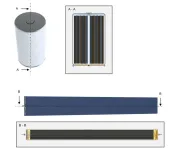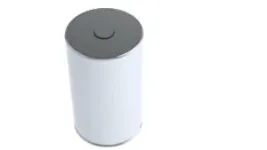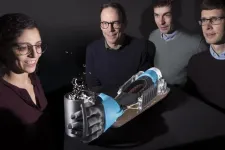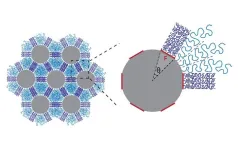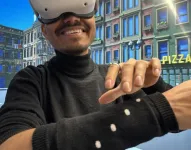(Press-News.org) Two main manufacturers dominate the EV (electric vehicle) market: Tesla, which is most popular in Europe and North America, and BYD, which leads the Chinese EV market. However, both manufacturers have released limited data about their batteries, so the mechanical structure and characteristics of these battery cells has remained mysterious. To compare the batteries used by each manufacturer and better understand how EV batteries function overall, a team of researchers took one of each apart.
The results publish on March 6 in the Cell Press journal Cell Reports Physical Science and show that Tesla’s batteries prioritize high-energy density and performance, whereas BYD’s batteries prioritize volume efficiency and lower-cost materials. Overall, the study revealed that BYD’s battery is more efficient because it allows easier thermal management.
“There is very limited in-depth data and analysis available on state-of-the-art batteries for automotive applications,” said Jonas Gorsch, a researcher at Production Engineering of E-Mobility Components at RWTH Aachen University in Germany and lead author of the study.
To address this, the researchers looked under the hood of Tesla’s battery—the Tesla 4680 cell—and BYD’s battery—the BYD Blade cell—and focused on the specific design and performance features of each. They assessed the mechanical designs and dimensions of the cells, the exact material compositions of their electrodes, and the cells’ electrical and thermal performances. They also deduced the processes used to assemble the cells and the costs of the materials used to make them.
“We were surprised to find no silicon content in the anodes of either cell, especially in Tesla’s cell, as silicon is widely regarded in research as a key material for increasing energy density,” said Gorsch.
The team found that the two types of batteries had significant differences in the speed at which a battery charges (or discharges) relative to its maximum capacity. The researchers also discovered that the BYD Blade employs a different method of keeping the electrode sheets in place—by using an electrode stack featuring a novel processing step to laminate the edges of the separator that sits between the anode and the cathode. The Tesla battery also uses a novel binder—a substance that holds together the active materials in the electrodes—in comparison to those used by most manufacturers in the industry.
The batteries also showed unexpected similarities: both use an unusual way of connecting their thin electrode foils: with laser welding instead of ultrasonic welding, used by many others in the industry. Also, although the BYD cell is much larger than the Tesla cell, the fraction of passive cell components—such as current collectors, housing, and busbars—is similar.
The results of this study illuminate how Tesla’s battery—the Tesla 4680 cell—and BYD’s battery—the BYD Blade cell—achieve two “highly innovative” but “fundamentally different” design approaches, says Gorsch. Further studies are needed to determine the impact of mechanical cell-design choices on electrode performances in EV batteries, as well as the lifespans of the Tesla and BYD cells, he added.
“The findings provide both research and industry with a benchmark for large-format cell designs, serving as a baseline for further cell analysis and optimization,” said Gorsch, adding that the data can help battery-cell developers make informed choices when deciding on format, size, and active materials.
###
This work was supported by financial support from the German Federal Ministry of Education and Research.
Cell Reports Physical Science, Gorsch et al., “Contrasting a BYD Blade prismatic cell and Tesla 4680 cylindrical cell with a teardown analysis of design and performance.” https://www.cell.com/cell-reports-physical-science/fulltext/S2666-3864(25)00052-9
Cell Reports Physical Science (@CellRepPhysSci), published by Cell Press, is a new broad-scope, open access journal that publishes cutting-edge research across the spectrum of the physical sciences, including chemistry, physics, materials science, energy science, engineering, and related interdisciplinary work. Visit https://www.cell.com/cell-reports-physical-science/home. To receive Cell Press media alerts, please contact press@cell.com.
END
Researchers at UC San Francisco have enabled a man who is paralyzed to control a robotic arm through a device that relays signals from his brain to a computer.
He was able to grasp, move and drop objects just by imagining himself performing the actions.
The device, known as a brain-computer interface (BCI), worked for a record 7 months without needing to be adjusted. Until now, such devices have only worked for a day or two.
The BCI relies on an AI model that can adjust to the small changes ...
Ice may be present a few centimetres below the Moon’s surface in more areas of the lunar polar regions than was previously thought due to large, yet highly localised, variations in surface temperatures. The results, published in Communications Earth & Environment, are derived from direct measurements taken at the lunar surface in 2023 by the Indian Chandrayaan-3 mission.
Future long-term exploration (or habitation) of the Moon will likely depend on the availability of ice to provide water, with the likelihood of ice formation in a ...
UCSF researchers are the first to demonstrate that the approach works for the patients who need it the most.
Patients who struggle to take daily HIV pills can benefit from long-acting injectable treatments, a new study by researchers at UCSF has found.
The strategy could also help stop the spread of HIV by keeping more patients from being infectious.
In 2021, federal regulators approved the first long-acting antiretroviral (LA-ART) injectable, which is a combination of long-acting cabotegravir and ...
Multidrug-resistant bacteria pose a major threat to human health. Manipulation of bacterial genes at the transcriptional level is a potential strategy to fight antibiotic-resistant bacterial infections by silencing their resistance genes. However, siRNAs have not been applied to regulate bacterial genes due to the lack of RNAi regulatory machinery, i.e., RNA-induced silencing complexes (RISCs), in bacteria. In addition, efficient methods for delivering siRNAs to bacteria in vivo are not currently available. In this study, ...
COLUMBUS, Ohio – Just a few days of eating a diet high in saturated fat could be enough to cause memory problems and related brain inflammation in older adults, a new study in rats suggests.
Researchers fed separate groups of young and old rats the high-fat diet for three days or for three months to compare how quickly changes happen in the brain versus the rest of the body when eating an unhealthy diet.
As expected based on previous diabetes and obesity research, eating fatty foods for three months led to metabolic problems, gut inflammation and dramatic shifts in gut bacteria in all rats compared to those that ate normal chow, while just three days of ...
Key points:
Slim and lightweight HASEL artificial muscles effectively suppress human tremor
Reproduction of patient recordings of tremor episodes in a robotic platform/mechanical patient
Computer simulation of tremor arm validates that forces are sufficient for practical applications
Avoiding time consuming clinical testing in early stages of technology development
Stuttgart/Tübingen – It is estimated that around 80 million people worldwide live with a tremor. For example, those who live with Parkinson's disease. The involuntary periodic movements sometimes strongly affect how patients are able ...
— By Rachel Berkowitz
Composite adhesives like epoxy resins are excellent tools for joining and filling materials including wood, metal, and concrete. But there’s one problem: once a composite sets, it’s there forever. Now there’s a better way. Researchers have developed a simple polymer that serves as a strong and stable filler that can later be dissolved. It works like a tangled ball of yarn that, when pulled, unravels into separate fibers.
A new study led by researchers ...
WASHINGTON, March 6, 2025—The American Educational Research Association (AERA) has announced the selection of 29 exemplary scholars as 2025 AERA Fellows. The AERA Fellows Program honors scholars for their exceptional contributions to, and excellence in, education research. Nominated by their peers, the 2025 Fellows were selected by the Fellows Committee and approved by the AERA Council, the association’s elected governing body. They will be inducted during a ceremony at the 2025 Annual Meeting in Denver on April 24. With this cohort, there will be a total of 791 AERA Fellows.
“The ...
A team of researchers from Nottingham Trent University (UK), Helmholtz-Zentrum Dresden-Rossendorf (HZDR) and Free University of Bozen-Bolzano (Italy) has created washable and durable magnetic field sensing electronic textiles – thought to be the first of their kind – which they say paves the way to transform use in clothing, as they report in the journal Communications Engineering (DOI: 10.1038/s44172-025-00373-x). This technology will allow users to interact with everyday textiles or specialized clothing by simply pointing their finger above a sensor.
The researchers show how they placed tiny flexible ...
(Toronto, March 6, 2025) JMIR Publications invites submissions to a new theme issue titled Social and Cultural Drivers of Health in Aging Populations in its open access journal JMIR Aging. The premier, peer-reviewed journal is indexed in PubMed, PubMed Central, MEDLINE, DOAJ, Scopus, and the Science Citation Index Expanded (Clarivate).
As aging populations grow worldwide, understanding the social and cultural factors that impact health outcomes in older adults has become a critical area of study. This theme issue aims to highlight the role of digital health ...
